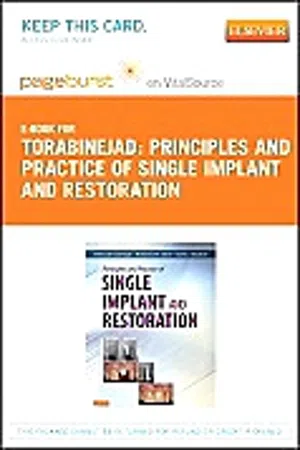
eBook - ePub
Principles and Practice of Single Implant and Restoration
This is a test
- 224 pages
- English
- ePUB (mobile friendly)
- Available on iOS & Android
eBook - ePub
Principles and Practice of Single Implant and Restoration
Book details
Book preview
Table of contents
Citations
About This Book
Covering treatment planning to restoration, Principles and Practice of Single Implant Restorations is the first book specifically designed to train Endodontists and General Dentists for a single tooth implant and restorations. It describes surgical principles, implant placement, implant site preparation, bone grafts and bone substitute materials, tooth extraction, guided bone regeneration, immediate implant placement, surgical defects, and single-tooth esthetic considerations. Expert authors Dr. Mahmoud Torabinejad, Dr. Charles Goodacre, and Dr. Mohammed Sabeti provide detailed guidelines for the use of single tooth implants as an appropriate and compelling treatment tool.
- Single tooth implants have been established as a new tool by the AAE, allowing you to use single tooth implants as a part of overall treatment planning for patients with a tooth that must be extracted.
- Easy-to-follow content generally follows the diagnosis and treatment planning for a single tooth implant and restoration, describing how a clinician might actually perform a single tooth implant.
- Unique! Instructions designed exclusively for Endodontists and General Dentists doing endodontic work help you use single tooth implants to treat a diseased single tooth.
- Expert authors Torabinejad, Goodacre, and Sabeti are AAE leaders as well as instructors at Loma Linda University, one of the first schools to have a Master's-level course in single-tooth implants, and have recruited contributors from top names in the endodontic and implant fields.
Frequently asked questions
At the moment all of our mobile-responsive ePub books are available to download via the app. Most of our PDFs are also available to download and we're working on making the final remaining ones downloadable now. Learn more here.
Both plans give you full access to the library and all of Perlego’s features. The only differences are the price and subscription period: With the annual plan you’ll save around 30% compared to 12 months on the monthly plan.
We are an online textbook subscription service, where you can get access to an entire online library for less than the price of a single book per month. With over 1 million books across 1000+ topics, we’ve got you covered! Learn more here.
Look out for the read-aloud symbol on your next book to see if you can listen to it. The read-aloud tool reads text aloud for you, highlighting the text as it is being read. You can pause it, speed it up and slow it down. Learn more here.
Yes, you can access Principles and Practice of Single Implant and Restoration by Mahmoud Torabinejad, Mohammed Sabeti, Charles Goodacre in PDF and/or ePUB format, as well as other popular books in Medicine & Dentistry. We have over one million books available in our catalogue for you to explore.
Chapter 1
History of Single Implants
Shane N. White and Mohammad A. Sabeti
Chapter Outline
From Ancient Times to the Pioneering Era
Osseointegration and the Scientific Era
From the Fully Edentulous State to Single Tooth Replacement
Diagnostic Technologic Innovations
Implant Design Innovations
Surgical Innovations
Immediate and Early Implant Placement
Augmentation and Grafting Advances
Soft Tissue Management, Minimally Invasive Flapless and Computer-Guided Surgery
Prosthetic Innovations
Implant Abutments
Immediate, Early, and Delayed Loading Protocols
Learning Objectives
At the conclusion of this chapter, the reader will be able to:




Single implants have expanded the ability of dentists to provide predictable replacements for missing or hopeless teeth. The ultimate outcome—a satisfied patient—is the result of careful assessment and meticulous surgical and prosthetic procedures by the dental team.1
Treatment outcomes for single implants are now excellent. Long-term success and survival rates are equivalent to those for endodontically treated teeth and are superior to those for tooth-supported fixed partial dentures.2–6 Short-term bone-level, soft tissue, and esthetic results are also excellent.7 However, complication rates and the need for additional interventions may be higher than desired.5,8,9 The scientific study of prognostic factors for single implants is still in its infancy.6,9,10 However, dentists need to make prudent treatment decisions now. Dentists also need to minimize the possibility of complications and the need for additional corrective procedures. Patients expect predictability, long-lasting functional results, minimally invasive procedures, comfort, minimal risks, minimal complications, and cost-effectiveness.11
How was the success of the single implant achieved? How can we continue to meet patients’ demands with even greater predictability in the future? A review of the history of single implants can guide us. This chapter frames the many innovations that have made single implant treatment predictable, accessible, and widely applicable. It is an introduction to the detailed descriptions of current procedures and future directions found in the rest of the text. This book serves as a guide to single implant planning and technique through a review of the best available evidence, the opinions of leading experts, and descriptions of current procedures.
From Ancient Times to the Pioneering Era
From the very beginning, humans have strived to retain their teeth (Figure 1-1) and also to replace teeth; a pleasing smile has had enormous psychosocial importance since earliest times. Stone, metal, ivory, and sea shell implants are all cited in the archaeological records of China, Egypt, and the Americas. Success was extremely rare. In 1685, in the first modern textbook on dentistry (Operator for the Teeth), Charles Allen suggested that the teeth of dogs, baboons, and sheep be used for implantation. However, the possibility of disease transmission was recognized.12 Transplantation was also described by Pare, Fauchard, and by Hunter, who used boiling for disinfection.13–15 Autotransplantation still has a place in clinical dentistry today. In 1807 Maggiolo developed a single-stage gold implant that was to be placed in fresh extraction sockets and allowed to heal passively without loading; however, pain and inflammation resulted.16 At the beginning of the twentieth century, Greenfield17 introduced latticelike precious metal basket implants that were used to support complete dentures and single teeth. This hollow basket design continued to inspire implant designs used through the 1990s.
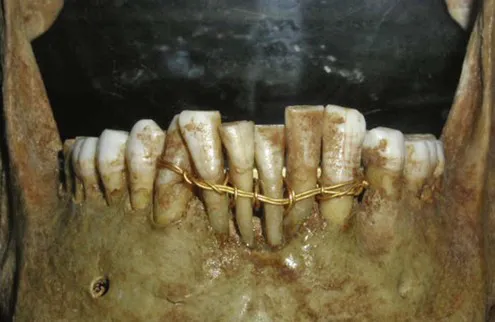
Figure 1-1 Frontal view of a mandible discovered in Lebanon at the ancient site of Sidon. The mandible is from about 500 BC and the periodontally involved anterior teeth have been splinted together with gold wire. (Courtesy the Archaeological Museum, American University, Beirut, Lebanon.)
From the 1930s through the 1960s, new metallic alloys were used to form a variety of subperiosteal implants (Figure 1-2), which are classified as eposteal (placed on or upon bone) implants. Other types of implants include endosteal blade implants (Figure 1-3) and transmandibular or staple implants (Figure 1-4). These approaches were generally directed toward supporting multiple prosthetic teeth. Most of these implants were one piece and were not fully submerged; various one-stage endosteal root form pins, screws, and cylinder designs were also developed. Linkow18 developed a variety of implant designs during this period but was best known for blade-type implants, which were designed to maximize the contact area between bone and implant.
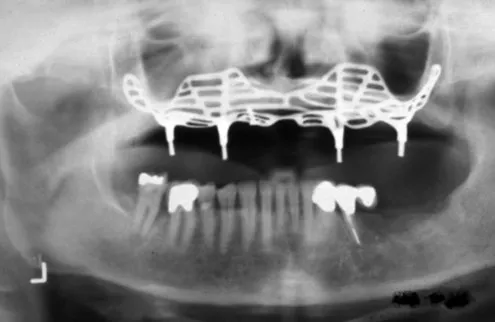
Figure 1-2 Maxillary subperiosteal implant with four posts that will be used to support and retain a prosthesis. (Courtesy R. James.)
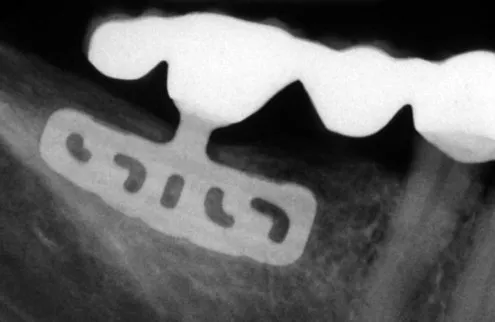
Figure 1-3 Periapical radiograph of a blade implant that supports the distal aspect of a mandibular fixed partial denture.
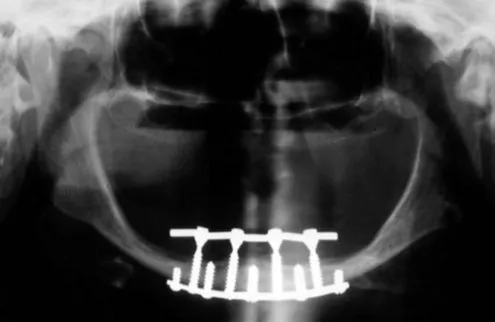
Figure 1-4 Panoramic radiograph of a one-piece transosseous implant consisting of a metal plate located on the inferior border of the mandible, five posts that are placed into the mandible, and four posts that pass through the mandible. A bar has been attached to the four posts to provide retention and stability for a mandibular implant overdenture.
In the 1930s Strock19 used immediate placement and a porcelain crown for single tooth replacement using a Vitallium implant. He reported a 15-year case study, noting the role of occlusion, and described the histology. Adams20 considered a two-stage surgical procedure for placing a cylindrical screw implant with a healing cap. In the late 1940s, Formiggini21 introduced a helicoidal screw tantalum implant. This design was modified by Chercheve in the 1960s to increase the distance between the screw threads and implant head (Figure 1-5).22 Some of these endosteal designs began to resemble contemporary solid, cylindrical or moderately tapered, threaded osseointegrated implants (Figure 1-6). Although the Dental Implants—Benefit and Risk Consensus Development and Technology Conference held in 1978 at the Harvard School of Dental Medicine set new standards for reporting implant data, an overly broad and liberal definition of implant “success” was permitted.23
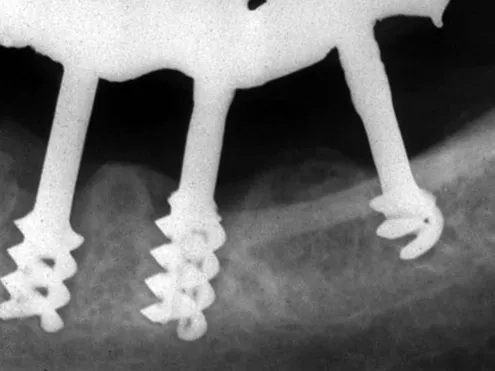
Figure 1-5 Radiograph of implants placed by Dr. Rafael Chercheve. (Courtesy R. James.)
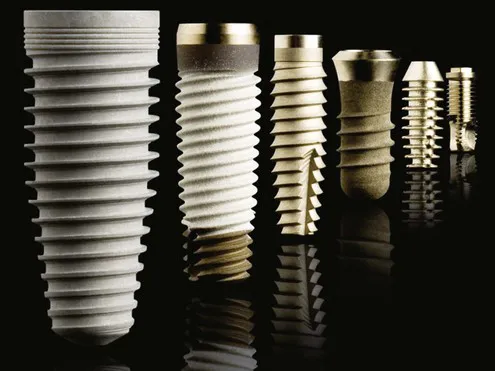
Figure 1-6 Several endosseous root form implants have been aligned so that the different designs, thread patterns, and surfaces can be compared. The original Brånemark external hex implant can be seen at the end of the row.
Meanwhile, the results of decades of research by Dr. Per-Ingvar Brånemark in Sweden were coming to fruition. By then other implant teams, notably in Germany and Switzerland, were develo...
Table of contents
- Cover image
- Title page
- Table of Contents
- Copyright
- Dedication
- Contributors List
- Preface
- Chapter 1: History of Single Implants
- Chapter 2: Diagnosis and Treatment Planning for Single Implants
- Chapter 3: Factors Involved in Single Implants
- Chapter 4: Bone Physiology, Metabolism, and Biomechanics in Implant Therapy
- Chapter 5: Bone Grafts and Bone Substitute Materials
- Chapter 6: Tooth Extraction and Site Preservation
- Chapter 7: Implant Placement with Simultaneous Guided Bone Regeneration
- Chapter 8: Immediate Implant Placement and Provisionalization of Maxillary Anterior Single Implants
- Chapter 9: Restoration of the Single Implant
- Chapter 10: Dental Implant Maintenance
- Chapter 11: The Relevance of Scientific Evidence in the Decision-Making Process: Treatment Outcomes in Single Implant Therapy
- Index